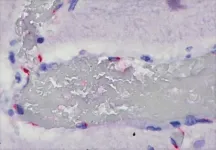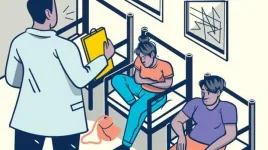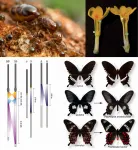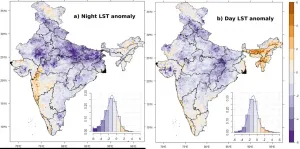(Press-News.org) Besides common symptoms such as fever, cough and respiratory distress, some children have an atypical form of COVID-19 known as multisystem inflammatory syndrome in children (MIS-C), characterized by persistent fever and inflammation of several organs, such as the heart and intestines, as well as the lungs to a lesser extent. Reports of MIS-C have been increasingly associated with severe cases and deaths in several countries including Brazil since the onset of the pandemic.
Researchers affiliated with the University of São Paulo's Medical School (FM-USP) and Adolfo Lutz Institute in Brazil performed the largest series of autopsies to date on children who died from COVID-19. Their findings show that the ability of SARS-CoV-2 to invade and damage several organs is one of the factors leading to MIS-C, producing a wide array of clinical manifestations that include abdominal pain, heart failure and seizures, as well as persistent fever.
The study was supported by São Paulo Research Foundation - FAPESP
and reported in an article in EClinicalMedicine, a Lancet group journal.
"The direct action of the virus on the tissue of various organs is one of the reasons why children with this syndrome have an exacerbated and altered inflammatory response to infection," Marisa Dolhnikoff, last author of the article, told. Dolhnikoff is a professor at FM-USP.
The researchers performed autopsies on five children who died from COVID-19 in São Paulo: one boy and four girls aged between 7 months and 15 years. Two were seriously ill before being infected by SARS-CoV-2, one with cancer and the other with a congenital genetic disorder.
The other three were previously healthy and developed MIS-C with different clinical manifestations. One had myocarditis (inflammation of the heart muscle), another had colitis (inflammation of the bowel), and a third had acute encephalopathy (brain damage) with seizures.
A minimally invasive technique, ultrasound-guided with coaxial and punch needles, was used to collect tissue samples from all major organs. The presence of SARS-CoV-2 in the samples was determined by real-time reverse transcription polymerase chain reaction (RT-PCR, the technique also used to diagnose COVID-19) and by immunohistochemistry, in which antibodies were deployed to detect the viral nucleocapsid protein (N) and one of the spike proteins (S2).
Histopathological analysis showed that both children with severe pre-existing disease had "classic" severe COVID-19, characterized by acute respiratory distress due to extensive damage to the lung alveoli caused by SARS-CoV-2. The virus was also detected in other organs.
The three previously healthy children were found to have inflammatory lesions outside the lungs, such as myocarditis and colitis. The virus was detected in heart endothelial and muscle cells from the patient with myocarditis, in intestinal tissue from the child with acute colitis, and in brain tissue from the patient with acute encephalopathy.
"We found that SARS-CoV-2 had spread throughout the body via the blood vessels, infecting various types of cell and tissue in these children. The clinical manifestations varied according to the organ targeted," Dolhnikoff said. "It's important for pediatricians to watch out for these possible differences in the clinical manifestations of COVID-19 in children of all ages so that the infection is diagnosed and MIS-C can be treated early on."
MIS-C may occur a few days or weeks after infection by SARS-CoV-2. The runaway inflammatory reaction was thought to occur whether or not the virus was still in the organism, as a result of the immune response, but the study found evidence that the manifestations of MIS-C are also triggered by the direct action of the virus on the cells of infected organs.
"We're not saying everything described to date about pediatric multisystem inflammatory syndrome is wrong. We're merely adding the observation that the damage done to tissues by the virus is associated with this exacerbated inflammatory response in children, and is very probably a key component in its induction," Dolhnikoff said.
Why some children respond to infection by SARS-CoV-2 with the exacerbated inflammation that characterizes MIS-C is unknown, but the answer may include a genetic component.
Endothelial cells targeted
The researchers found that the virus's main targets included endothelial cells, which line blood vessels of all sizes and regulate exchanges between the bloodstream and the surrounding tissues. "One hypothesis is that when an endothelial cell is infected it activates bloodstream mediators that trigger an inflammatory cascade and the other reactions observed in children with MIS-C, such as persistent fever, colitis, myocarditis and encephalitis," said Amaro Nunes Duarte Neto, first author of the article. Duarte Neto is an infectious disease specialist and pathologist at FM-USP and Adolfo Lutz Institute.
"The virus induces these reactions in the cells, but it's the immune system that produces a response with adverse effects on the patient," he said. "It's not an autoimmune response, however, like what we see in lupus, psoriasis or inflammatory arthritis, which also involve damage to blood vessels. In MIS-C, the virus is involved directly."
Electron microscopy analysis by Elia Caldini, a professor at FM-USP, supported these conclusions. Electron microscopes magnify viral particles more than 50,000 times directly, without the use of reagents. The technique enabled the researchers to describe alterations in cell cytoplasm associated with the presence of the virus.
"To confirm our identification of the virus unequivocally, we were the first to use immunolabeling of SARS-CoV-2 in conjunction with electron microscopy," Caldini said. "We coupled colloidal gold particles to the specific antibodies used in light microscopy against structural viral proteins."
The researchers also detected microthrombi (small blood clots) for the first time in children. This had already been observed and reported in adults. "Phenomena relating to blood clotting should always be considered in COVID-19.
Our electron microscopy analysis showed that capillary blood vessels in all organs were obstructed by accumulated red and white blood cells, cellular debris, and fibrin, with disruption of the endothelial wall," Caldini said.
INFORMATION:
About São Paulo Research Foundation (FAPESP)
The São Paulo Research Foundation (FAPESP) is a public institution with the mission of supporting scientific research in all fields of knowledge by awarding scholarships, fellowships and grants to investigators linked with higher education and research institutions in the State of São Paulo, Brazil. FAPESP is aware that the very best research can only be done by working with the best researchers internationally. Therefore, it has established partnerships with funding agencies, higher education, private companies, and research organizations in other countries known for the quality of their research and has been encouraging scientists funded by its grants to further develop their international collaboration. You can learn more about FAPESP at http://www.fapesp.br/en and visit FAPESP news agency at http://www.agencia.fapesp.br/en to keep updated with the latest scientific breakthroughs FAPESP helps achieve through its many programs, awards and research centers. You may also subscribe to FAPESP news agency at http://agencia.fapesp.br/subscribe.
In a new study published in Proceedings of the National Academy of Sciences (PNAS), a research team of the Institute of Complex Systems of the University of Barcelona (UBICS) analysed the time evolution of real complex networks and developed a model in which the emergence of new nodes can be related to pre-existing nodes, similarly to the evolution of species in biology.
This new study analyses the time evolution of the citation network in scientific journals and the international trade network over a 100-year period. According to M. Ángeles Serrano, ICREA researcher at UBICS, "what we observe in these real networks is that both grow in a self-similar way, that is, their connectivity properties ...
BUFFALO, N.Y. -- For many people, the need to go grocery shopping is met with a sigh, or an "ugh." It's generally not considered to be an enjoyable experience.
For moms who shop using WIC benefits, it can be a downright awful experience, one that's often made worse by difficulty finding eligible products and dealing with a lengthy checkout process. Add kids in tow and it's enough for many moms to forego re-enrolling in the Special Supplemental Nutrition Program for Women, Infants and Children, commonly known as WIC.
But researchers at the University at Buffalo are working on ways to improve ...
ANN ARBOR, Mich. - Fibroid symptoms, such as heavy menstrual bleeding and abdominal pain, are increasingly driving women to the emergency room.
In fact, tens of thousands of women were seen annually in the emergency department for the condition, which involves benign growths in the uterus, over a 12-year period.
But only 1 in 10 of these visits led to a hospital admission, suggesting that many cases may have been managed in an alternative, non-urgent health setting, according to recent Michigan Medicine research.
"Fibroids are often a chronic disease, so we have opportunities to treat this through established care with a trusted health provider. Yet, we've seen a big increase in women using the emergency room ...
While the term "supergene" may bring to mind the genetic hocus-pocus of Peter Parker's transformation into Spiderman, supergenes are actually fairly common phenomena in the realm of biology. A supergene refers to a genomic region containing multiple genes or genetic elements that are tightly linked, allowing genetic variants across the region to be co-inherited. Supergenes may arise when there is a clear benefit to inheriting specific combinations of biological traits together. Perhaps the most well-known examples of supergenes are sex chromosomes, which allow traits that are beneficial to the reproductive success of one sex to be co-inherited. In humans, this ...
(Boston)--Only a small subset of people who get a lung infection go on to become very sick yet who will become severely ill or why is unclear. This is now widely recognized in the context of COVID-19, where most people have mild or no illness while others with the same infection become extremely sick or even die.
Researchers now have discovered that after recovering from a respiratory infection, new cells get deposited in lung tissue, persist there and then become antibody secreting cells very quickly if the lungs later get re-infected by something similar.
"It is increasingly clear that our lungs contain their own specialized immune system, different from the immune system throughout the rest of the body," explained corresponding ...
In some environments there is no way for a seed to know for sure when the best time to germinate is.
In spring, cues like light, temperature and water may suggest to seeds that conditions are optimal for germination, but a week later an unpredictable drought or frost could kill the emerging seedlings.
So how does a plant make sure that all of its offspring are not killed at once by an ill-timed environmental stress following germination?
There is evidence that some plant species produce seeds that germinate at different times to hedge their bets against this risk. Many species produce seeds that can enter a dormant state and exist in the soil for several years and some also produce seeds that germinate at different ...
Research by scientists from University of Southampton (UK) and the Central University of Jharkhand (India) and has shown the first COVID-19 lockdown in India led to an improvement in air quality and a reduction in land surface temperature in major urban areas across the country.
The study found that travel and work restrictions imposed early in the pandemic resulted in a significant environmental improvement, due to an abrupt reduction in industrial activities and a major decrease in the use of land and air transport.
The international team used data from a range of Earth Observation sensors, including those from the European Space Agency's Sentinel-5p and NASA's MODIS sensors, to measure changes in surface temperature and atmospheric ...
Efforts to contain the novel coronavirus have caused lockdowns and school closures around the world. These efforts and policies have unfortunately cut off many children from valuable resources such as the opportunity for exercise, access to clean water and food, learning, and socialization. Therefore, the effects on mental health and behavior may be found not just in adults but children. However, studies published thus far have been limited to elucidating the mood of middle school and high school students and the conditions for which mood problems occur ...
Drinking straws are single use plastic products which will be subjected to a Europe-wide sales ban from 2021 onwards. This is stated in EU Directive 2019/904 from 5 June 2019. Consequently, alternative materials have to be established for the production of drinking straws as well as other frequently used products which predominantly were made of plastic so far.
As set out in the EU Framework Regulation for food contact material (Regulation (EC) No. 1935/2004), objects that come into direct contact with food must be safe. The German Federal Institute for Risk Assessment (BfR) has appraised straw, silicone, metal, paper and paper-board, durum wheat, and glass for their suitability to replace plastic ...
Using a brain-training app helps people eat less junk food and lose weight, new research suggests.
The Food Trainer (FoodT app) trains people to tap on images of healthy foods - but to stop when they see unhealthy snacks, creating an association between these foods and stopping.
The new study, by the universities of Exeter and Helsinki, found that playing the game about once a day for a month led to an average one-point reduction of junk food consumption on an eight-point scale (the scale ranges from four or more items per day, to one or zero items per month).
Overall, people who used the app more also ...




